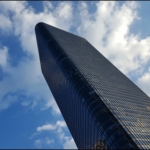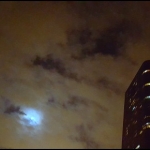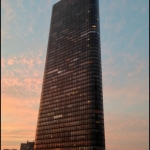Suffering With Foggy Windows, Condensation?
November 10, 2023
These Are Not Uncommon Or Abnormal This Time Of Year!
Sadly, the weather doesn’t care if it ruins the view. Condensation, frost (when it’s truly cold out), dripping, sunny outside/fogged up inside, and even leaking from the neighbor above you due to condensation. These are all phenomenon which are possible this time of year in a curtain wall building. Depending on the temperature outside and the humidity in your unit, this could impair your winter season view and even cause leaking!
There are some things you can do. Condensation is a function of exterior temperature versus interior temperature and interior relative humidity; when the glass becomes cold from the outdoor weather, the relatively warm and humid indoor air tends to condense on the windows – in extreme cold weather it will even form ice and frost. This is a challenging problem – especially in winter – it can obstruct your view and cause leaking that may even lead to damage in yours and neighboring units. There are a couple of things you can do to lower the condensation in your unit:
– ABSOLUTELY DO NOT HUMIDIFY – This is difficult for many of us, especially if you need a humidifier to help with any health conditions or dry skin, but if you are getting puddles of water, running a humidifier could cause serious leaking. A fan can help, because the movement of the air can help warm the surface of the glass and help reduce condensation from forming – theoretically that moisture then remains in the air in your unit.
– LOWER THE TEMPERATURE IN YOUR UNIT – This too can be difficult, but if the condensation is really bothering you during very cold weather, lowering the temps a couple degrees can help a bit (and save energy at the same time). Cooler air holds exponentially less water. Grab a blanket or your favorite sweater, and see if you can manage it a few degrees lower. Obviously this is easier to do in units where the owner has upgraded the HVAC by installing a Thermostat.
– LOWER THE TEMPERATURE AND SHORTEN THE LENGTH OF YOUR SHOWER OR BATH – Even a few degrees less than normal can put off exponentially less steam and humidity into the air, which would otherwise circulate to the windows and other cold surfaces, causing condensation. And make it quick – the more time the water is exposed to the air, the more evaporation and the more humidity. (And, besides, saving water these days is a benefit to everyone.)
– NO PASTA OR RICE! – This is especially tough for some, we know. But avoid cooking foods that require either boiling water, or result in a great deal of moisture evaporation and steam.
– KEEP YOUR SHADES OR BLINDS OPEN – as much as possible. When they are closed it creates a micro-climate between the shade and the curtain wall where air will not circulate. When open, more are can circulate over the metal and glass keeping it warmer than if the shades were closed. This too is difficult, especially for those who get a sunrise view, when you like to sleep in!
– CHANGE DIRECTION OF YOUR AIR FLOW – Each winter spin the plastic vent pieces on the HVAC units to face the windows. When the unit is on the air hits the windows, improving circulation over them and helps prevent frost and condensation. There might be some frost along the edges of the windows in your unit, but not wall-to-wall as it would otherwise be. Come spring, twist them back to point into the room for more efficient cooling.
If you are suffering from excessive condensation – particularly during frigid outdoor weather – try experimenting with a combination of these suggestions and you should experience at least some relief.
Drafts and Water Penetration
First, it is extremely important that any leaking or water penetration be reported to us, so we can investigate. Every two years we do schedule to perform investigative drops around the building exterior, and anything we might not be able to explain occurring from inside, we can target for exploration when our team is on the outside.
Residents and Owners may experience drafts in certain conditions, particularly severe weather. Even noises can be come from the curtain wall from time to time, such as whistling from the wind or snapping from the cold as the metal expands and contracts. The curtain wall is not 100% air tight or immobile. It is not meant to be, as there are natural penetrations. A metal structure like this needs to be able to expand and contract with the variety of conditions we experience in Chicago. A good example being the weather such as we had during the blizzards.
A couple of the design oddities include (but are not limited to):
– “Weeps” There are designed penetrations throughout the framework, called ‘weeps’. These are a purposeful design feature, meant primarily to help direct water out of the curtain wall, should it enter the window frames. A side effect though – just the right wind speed and pressure can result in air entering at these weeps. Even water can get forced into them in the right conditions, and drip out at a later time.
– “Expansion Joints” Within and between sections and pieces of the curtain wall there are also ‘expansion joints’, so the metal can expand and contract with the weather – both wind, and temperature extremes inside and outside of the building.
Working together, air being forced inside the weeps and through the joints, could enter the building. You could hear whistling at times, and drafts during a variety of conditions. Just the right combination of weather can even result in water coming in. Especially very severe thunderstorms.
Think of blowing up a balloon. You can start blowing, but the balloon does not start expanding until it reaches a critical pressure point that triggers movement of the material. While not apples to apples, its a similar action/reaction in theory. At those points during high winds and fluctuating pressures, the curtain wall apparatus will respond by flexing at these joints to relieve the pressure, just like the rubber of a balloon reacts the air pressure by beginning to expand.
– “Operable Windows” Also, weather can enter the operable windows. They are not 100% air tight either. And in fact, the curtain wall is designed to flex in such weather to help reduce strain on these windows and frames. It is at these locations, where it would be most likely you might experience weather penetration. Especially in severe weather.
At times during our most recent blizzards, the wind was speeding past the building in excess of 100mph at some points along the tower. You can expect some air penetration in these conditions. Had the wind been accompanied by rain instead of snow, some water penetration could also be possible. For the most part though, that is rare and it is typically minor and easily addressed.
Finally, in severe cold we may also experience drafts at the window. As the air chills along the windows surface, it will become very dense and in the right conditions it will flow downward and generate a micro circulation in the room. We’ve observed this phenomenon actually causing curtains to move in a unit, and even have had our engineers (Wiss, Janney, Elstner) give an opinion in the past about such a condition.
Despite all this, Owners and Residents are encouraged to report any weather penetration. We especially want to know if water enters. Sadly, more often than not leaking occurs because a neighbor above has an open window, likely about 95% of the time. Fortunately that is pretty easy leaking to stop if it is reported ASAP.
Don’t hesitate to share any questions about this, or to report leaking right away. It is treated as an emergency, so after hours call the front desk at 773-769-3083. During business hours call the office 773-769-3250. Have a question or just want to share an observation? Write us at parktowercondo-mgmt@habitat.com.








